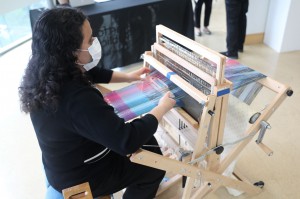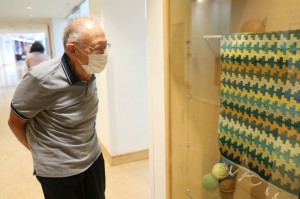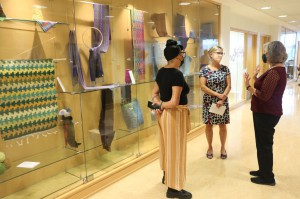
Ana Cuevas works on a scarf during the opening of the Hartford Artisans Weaving Center’s Perspectives on Color exhibit at the Hartford Public Library Downtown on Thursday, Sept. 9, 2021.
Ana Cuevas was born without vision but it hasn’t stopped her from producing finely crafted scarves and other items at the Hartford Artisans Weaving Center.
“My understanding of color is very limited but I like to do things for others to see,” Cuevas, who has been weaving for about four years, said Thursday as she demonstrated her skill at an opening for the center’s Perspectives on Color exhibit at the Hartford Public Library’s Downtown location.
Dozens of items produced by artisans from the weaving center will be on display on the library’s third floor – outside the Hartford History Center – through Oct. 21.
For Johanna Bolduc, who lost her vision in 2002, the center on Woodland Street has been a welcoming environment since she first started training there in 2013.
“It’s the nosiest peaceful place you’ll ever be,” she said, calling the art of weaving a form of “active meditation.”

Garrett Weaver admires a rug he created at the Hartford Artisans Weaving Center during the opening of the center’s Perspectives on Color exhibit at the Hartford Public Library Downtown on Thursday, Sept. 9, 2021.
The center was forced to suspend classes for months during the COVID-19 pandemic but materials were sent home so the men and women who train there could continue working on their craft, said Ann Kollegger, executive director of the nonprofit.
In addition to teaching hand-weaving to people who are blind or visually impaired, the center also offers classes to Hartford-area seniors, like Garrett Weaver, who has a rug on display in the exhibit. He said it took him about three months to produce, start to finish.
Weaver said he’s been weaving for about 25 years and has been working at the center since its start.
“In college I was interested in modern art and math, and it’s a blend of that,” Weaver explained, adding that he uses Microsoft Excel to plot out patterns before getting to work on a project.

Hartford Public Library President and CEO Bridget Quinn, center, talks with Hartford Artisans Weaving Center Executive Director Ann Kolleger. right, and Hartford History Center Education and Outreach Manager Jasmin Agosto, left, during the Thursday, Sept. 9, 2021, opening of the center’s Perspectives on Color exhibit.
Cuevas, the artisan who was born without vision, described how she interprets color in a testimonial that is part of the display.
“The color red comes to mind, because I think about the sun,” she wrote. “For me, the sun and the color red means inclusion. The sun provides light and warmth to everyone in the world regardless of race, gender, religion and socioeconomic status.”
For more information visit www.weavingcenter.org.